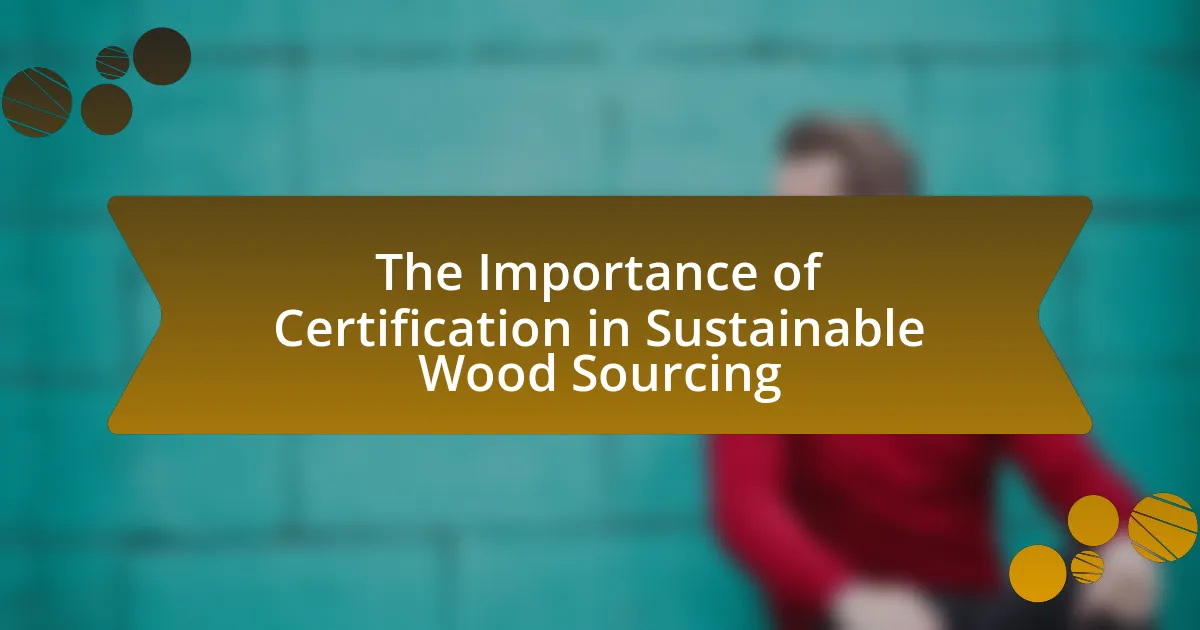Certification in sustainable wood sourcing is essential for ensuring that wood products are derived from responsibly managed forests, thereby promoting environmental sustainability and social responsibility. This article examines the significance of certification, highlighting its role in combating deforestation, protecting biodiversity, and supporting local communities. It discusses various certification programs, such as the Forest Stewardship Council (FSC) and the Programme for the Endorsement of Forest Certification (PEFC), and their impact on sustainable practices. Additionally, the article addresses the challenges companies face in obtaining certification, the economic advantages it provides, and the importance of stakeholder collaboration in the certification process.

What is the Importance of Certification in Sustainable Wood Sourcing?
Certification in sustainable wood sourcing is crucial as it ensures that wood products are sourced from responsibly managed forests, promoting environmental sustainability and social responsibility. This certification process helps to combat deforestation, protect biodiversity, and support the rights of local communities. For instance, the Forest Stewardship Council (FSC) certification guarantees that wood comes from forests that are managed in a way that preserves ecological functions and meets social standards. Research indicates that certified forests have a lower rate of deforestation compared to non-certified ones, highlighting the effectiveness of certification in promoting sustainable practices.
Why is certification crucial for sustainable wood sourcing?
Certification is crucial for sustainable wood sourcing because it ensures that wood products are harvested in an environmentally responsible manner, promoting forest conservation and biodiversity. Certification programs, such as the Forest Stewardship Council (FSC) and the Programme for the Endorsement of Forest Certification (PEFC), set strict standards for sustainable forestry practices, which include protecting ecosystems, respecting indigenous rights, and maintaining forest health. These standards are verified through independent audits, providing consumers with assurance that their wood products come from sustainably managed forests. According to a study by the World Resources Institute, certified forests are less likely to be illegally logged, thus supporting sustainable supply chains and reducing deforestation rates.
What are the key principles of sustainable wood sourcing?
The key principles of sustainable wood sourcing include ensuring that wood is harvested from responsibly managed forests, promoting biodiversity, and supporting local communities. Responsible forest management involves practices that maintain the ecological balance, such as selective logging and replanting, which help preserve the forest’s health and productivity. Promoting biodiversity ensures that various species of flora and fauna are protected, contributing to ecosystem stability. Supporting local communities involves fair labor practices and economic benefits, ensuring that those who depend on the forest for their livelihood are treated equitably. These principles are often validated through certification systems like the Forest Stewardship Council (FSC), which sets standards for responsible forest management and provides assurance to consumers about the sustainability of the wood products they purchase.
How does certification support these principles?
Certification supports the principles of sustainable wood sourcing by providing a standardized framework that ensures environmental, social, and economic criteria are met. This framework includes adherence to practices that promote responsible forest management, protect biodiversity, and support local communities. For instance, certifications like the Forest Stewardship Council (FSC) require compliance with strict guidelines that prevent deforestation and promote reforestation, thereby safeguarding ecosystems. Additionally, certified products often come with traceability, allowing consumers to verify the sustainability of their purchases, which reinforces market demand for responsibly sourced wood. This alignment with sustainability principles is evidenced by studies showing that certified forests have higher biodiversity and better-managed resources compared to non-certified ones.
What types of certifications exist for sustainable wood sourcing?
Several certifications exist for sustainable wood sourcing, including the Forest Stewardship Council (FSC), Programme for the Endorsement of Forest Certification (PEFC), and Sustainable Forestry Initiative (SFI). The FSC certification ensures that wood products come from responsibly managed forests that provide environmental, social, and economic benefits. PEFC focuses on promoting sustainable forest management through independent third-party certification, while SFI emphasizes sustainable forestry practices and responsible sourcing. These certifications are recognized globally and help consumers identify wood products that meet rigorous sustainability standards.
What are the most recognized certification programs?
The most recognized certification programs in sustainable wood sourcing include the Forest Stewardship Council (FSC), the Programme for the Endorsement of Forest Certification (PEFC), and the Sustainable Forestry Initiative (SFI). These programs are widely acknowledged for their rigorous standards in promoting responsible forest management and ensuring that wood products are sourced sustainably. For instance, the FSC certification is known for its strict environmental and social criteria, which are verified through independent audits, making it a trusted label among consumers and businesses alike.
How do these certifications differ from one another?
Certifications in sustainable wood sourcing differ primarily in their standards, scope, and verification processes. For instance, the Forest Stewardship Council (FSC) focuses on responsible forest management practices, ensuring environmental, social, and economic benefits, while the Programme for the Endorsement of Forest Certification (PEFC) emphasizes national standards and promotes sustainable forest management through a broader range of certification schemes. Additionally, the Sustainable Forestry Initiative (SFI) incorporates a strong emphasis on sustainable practices in North America and includes specific requirements for landowners and loggers. Each certification has unique criteria and methodologies for assessing compliance, which influences their recognition and acceptance in the marketplace.
What role do stakeholders play in the certification process?
Stakeholders play a critical role in the certification process by influencing standards, ensuring compliance, and promoting transparency. They include organizations, communities, and individuals who have an interest in sustainable wood sourcing, such as environmental groups, industry representatives, and consumers. Their involvement helps shape the criteria for certification, ensuring that it aligns with ecological and social goals. For instance, the Forest Stewardship Council (FSC) incorporates stakeholder input to develop its standards, which enhances credibility and acceptance in the market. This collaborative approach fosters trust and accountability, essential for the effectiveness of certification in promoting sustainable practices.
Who are the main stakeholders involved in sustainable wood sourcing?
The main stakeholders involved in sustainable wood sourcing include forest owners, timber companies, certification organizations, consumers, and environmental NGOs. Forest owners manage the land and resources, while timber companies are responsible for harvesting and processing wood. Certification organizations, such as the Forest Stewardship Council (FSC), establish standards for sustainable practices. Consumers influence demand for certified products, and environmental NGOs advocate for sustainable practices and monitor compliance. Each stakeholder plays a crucial role in promoting and ensuring sustainable wood sourcing practices.
How do stakeholders influence certification standards?
Stakeholders influence certification standards by actively participating in the development and revision processes, ensuring that the standards reflect their interests and concerns. For instance, industry representatives, environmental organizations, and government agencies collaborate to create standards that balance economic viability with ecological sustainability. Research indicates that stakeholder engagement leads to more robust certification frameworks, as seen in the Forest Stewardship Council (FSC) model, which incorporates input from diverse groups to enhance credibility and acceptance. This collaborative approach not only fosters transparency but also aligns certification standards with the values and expectations of the broader community, ultimately driving better practices in sustainable wood sourcing.

How does certification impact the environment and economy?
Certification positively impacts the environment and economy by promoting sustainable practices and ensuring responsible resource management. For instance, certified sustainable wood sourcing reduces deforestation rates and encourages biodiversity conservation, as evidenced by the Forest Stewardship Council’s standards, which require adherence to ecological principles. Economically, certification can enhance market access and increase product value; a study by the World Bank found that certified timber can sell for up to 30% more than non-certified alternatives, benefiting both producers and local communities. Thus, certification serves as a critical tool for aligning environmental stewardship with economic growth.
What environmental benefits arise from certified sustainable wood sourcing?
Certified sustainable wood sourcing provides significant environmental benefits, including the preservation of biodiversity and the reduction of deforestation. By adhering to strict certification standards, such as those set by the Forest Stewardship Council (FSC), sustainable wood sourcing ensures that forests are managed responsibly, maintaining ecosystem health and protecting wildlife habitats. According to a study by the World Resources Institute, certified forests have a 30% lower rate of deforestation compared to non-certified forests, highlighting the effectiveness of certification in promoting sustainable practices. Additionally, sustainable sourcing practices contribute to carbon sequestration, as healthy forests absorb carbon dioxide, mitigating climate change impacts.
How does certification help in forest conservation?
Certification helps in forest conservation by establishing standards that promote sustainable forest management practices. These standards ensure that logging activities do not lead to deforestation, habitat destruction, or biodiversity loss. For example, the Forest Stewardship Council (FSC) certification requires adherence to environmental, social, and economic criteria, which helps protect ecosystems and supports the rights of local communities. Studies have shown that certified forests are managed more sustainably, with reduced illegal logging rates and improved forest health, thereby contributing significantly to global conservation efforts.
What is the impact on biodiversity through certified sourcing?
Certified sourcing positively impacts biodiversity by promoting sustainable forest management practices that protect ecosystems and wildlife habitats. These certifications, such as the Forest Stewardship Council (FSC) and Programme for the Endorsement of Forest Certification (PEFC), ensure that wood products are sourced from responsibly managed forests, which helps to maintain biodiversity by preventing deforestation and habitat destruction. Studies indicate that certified forests support a higher diversity of species compared to non-certified ones, as they implement practices that conserve natural habitats and promote the regeneration of native flora and fauna. For instance, research published in the journal “Conservation Biology” shows that FSC-certified forests have 30% more species richness than non-certified forests, highlighting the effectiveness of certification in enhancing biodiversity.
What economic advantages does certification provide to businesses?
Certification provides businesses with economic advantages such as increased market access, enhanced brand reputation, and potential cost savings. By obtaining certification, companies can enter markets that require compliance with specific sustainability standards, thereby expanding their customer base. For instance, certified sustainable wood products often command higher prices, leading to increased revenue. Additionally, certification can improve a company’s reputation, attracting environmentally conscious consumers and partners, which can further drive sales. Furthermore, businesses that implement certified practices may experience operational efficiencies and reduced waste, resulting in lower costs. According to a study by the Forest Stewardship Council, certified companies reported a 20% increase in sales due to consumer preference for certified products, demonstrating the tangible economic benefits of certification.
How can certification enhance market access for wood products?
Certification enhances market access for wood products by providing assurance of sustainability and legality, which are increasingly demanded by consumers and regulatory bodies. Certified wood products, such as those labeled by the Forest Stewardship Council (FSC) or the Programme for the Endorsement of Forest Certification (PEFC), meet specific environmental and social standards that appeal to eco-conscious markets. According to a study by the World Wildlife Fund, certified wood can command a price premium of 10-30% over non-certified wood, reflecting its higher market value. This premium incentivizes producers to adopt sustainable practices, thereby expanding their access to both domestic and international markets that prioritize responsible sourcing.
What are the long-term financial benefits of certification?
Certification in sustainable wood sourcing leads to long-term financial benefits such as increased market access, higher prices for certified products, and reduced risk of legal issues. Companies with certification can tap into a growing consumer demand for sustainably sourced materials, which often results in premium pricing; for instance, certified wood products can sell for 10-30% more than non-certified alternatives. Additionally, certification helps mitigate risks associated with non-compliance to environmental regulations, potentially saving companies from costly fines and legal disputes. According to a study by the Forest Stewardship Council, certified forests can yield up to 20% more revenue over time compared to non-certified forests, demonstrating the financial advantages of certification in the long run.

What challenges are associated with certification in sustainable wood sourcing?
Certification in sustainable wood sourcing faces several challenges, including high costs, complex standards, and market access issues. The financial burden of certification can deter small producers, as the expenses associated with compliance and auditing can be significant. Additionally, the variety of certification standards, such as FSC and PEFC, can create confusion and complicate the certification process for stakeholders. Furthermore, limited market access for certified products in certain regions can undermine the economic viability of sustainable practices, as consumers may not prioritize certified wood over cheaper, uncertified alternatives. These challenges collectively hinder the widespread adoption of sustainable wood sourcing practices.
What barriers do companies face in obtaining certification?
Companies face several barriers in obtaining certification for sustainable wood sourcing, including high costs, complex regulatory requirements, and lack of awareness or understanding of certification processes. The financial burden associated with certification can deter companies, as they may need to invest in training, audits, and compliance measures. Additionally, the intricate nature of regulations can create confusion, making it challenging for companies to navigate the certification landscape effectively. Research indicates that many businesses lack sufficient knowledge about the benefits and requirements of certification, which further complicates their ability to achieve compliance and certification.
How do costs and resources affect the certification process?
Costs and resources significantly influence the certification process by determining the feasibility and accessibility of obtaining certification. High costs can deter organizations from pursuing certification, as they may lack the financial resources to cover fees for audits, documentation, and compliance measures. For instance, the Forest Stewardship Council (FSC) certification can range from a few thousand to tens of thousands of dollars, depending on the size and complexity of the operation. Additionally, limited resources, such as insufficient staff or expertise, can hinder an organization’s ability to meet the rigorous standards required for certification. Research indicates that companies with adequate resources are more likely to achieve certification, as they can invest in necessary training and infrastructure to comply with sustainability criteria.
What are the common misconceptions about certification?
Common misconceptions about certification include the belief that certification guarantees sustainability, that it is only relevant for large companies, and that it is a one-time process. Certification does not ensure that all practices are sustainable; it indicates compliance with specific standards at a given time. Additionally, many small businesses can also achieve certification, which is not limited to larger corporations. Lastly, certification requires ongoing compliance and periodic renewal, rather than being a one-time achievement. These misconceptions can lead to misunderstandings about the role and effectiveness of certification in promoting sustainable practices in wood sourcing.
How can companies overcome these challenges?
Companies can overcome challenges in sustainable wood sourcing by implementing robust certification systems that ensure compliance with environmental standards. By adopting certifications such as FSC (Forest Stewardship Council) or PEFC (Programme for the Endorsement of Forest Certification), companies can demonstrate their commitment to sustainable practices. These certifications provide a framework for responsible sourcing, helping companies mitigate risks associated with deforestation and illegal logging. Research indicates that certified wood products can enhance marketability, as consumers increasingly prefer environmentally responsible options. For instance, a study by the World Wildlife Fund found that companies using certified wood reported a 20% increase in customer trust and loyalty.
What strategies can be implemented to streamline the certification process?
To streamline the certification process in sustainable wood sourcing, organizations can implement digital platforms for application submissions and tracking. These platforms reduce paperwork, enhance communication, and allow for real-time updates, which can significantly decrease processing times. For instance, the Forest Stewardship Council (FSC) has adopted an online system that facilitates quicker assessments and approvals, demonstrating a successful model for efficiency. Additionally, training programs for assessors can standardize evaluation criteria, ensuring consistency and reducing the time spent on clarifications. Research indicates that organizations utilizing technology in certification processes can reduce the time to certification by up to 30%, thereby improving overall efficiency and effectiveness in sustainable wood sourcing.
How can collaboration among stakeholders facilitate certification?
Collaboration among stakeholders can facilitate certification by ensuring that diverse perspectives and expertise are integrated into the certification process. When stakeholders, including forest managers, certification bodies, and local communities, work together, they can establish clear standards that reflect ecological, social, and economic considerations. This collaborative approach enhances transparency and trust, which are crucial for gaining acceptance of certification schemes. For instance, the Forest Stewardship Council (FSC) emphasizes stakeholder involvement in developing its standards, leading to broader support and adherence to sustainable practices. This collective effort not only streamlines the certification process but also increases the credibility and effectiveness of the certification, ultimately promoting sustainable wood sourcing.
What best practices should companies follow for successful certification?
Companies should follow a structured approach to achieve successful certification in sustainable wood sourcing. This includes conducting a thorough assessment of current practices, ensuring compliance with relevant standards, and engaging stakeholders throughout the process. For instance, companies should familiarize themselves with certification standards such as the Forest Stewardship Council (FSC) or the Programme for the Endorsement of Forest Certification (PEFC), which provide clear guidelines for sustainable practices. Engaging with stakeholders, including suppliers and local communities, fosters transparency and collaboration, which are essential for meeting certification requirements. Additionally, implementing a robust monitoring and evaluation system helps track progress and identify areas for improvement, ensuring ongoing compliance and sustainability.
How can companies ensure compliance with certification standards?
Companies can ensure compliance with certification standards by implementing a robust management system that aligns with the specific requirements of the certification. This involves conducting regular audits, training employees on compliance protocols, and maintaining accurate documentation to demonstrate adherence to standards. For instance, organizations that follow the Forest Stewardship Council (FSC) guidelines must regularly assess their practices against FSC criteria to maintain certification. Research indicates that companies with structured compliance programs are 30% more likely to meet certification requirements consistently, highlighting the effectiveness of systematic approaches in achieving and maintaining compliance.
What role does continuous improvement play in maintaining certification?
Continuous improvement is essential for maintaining certification as it ensures compliance with evolving standards and enhances operational efficiency. Organizations that prioritize continuous improvement actively assess and refine their processes, which is critical for meeting the requirements set by certification bodies. For instance, in sustainable wood sourcing, continuous improvement practices can lead to better resource management and reduced environmental impact, aligning with certification criteria such as those established by the Forest Stewardship Council. This ongoing commitment to improvement not only helps organizations retain their certification but also fosters trust among stakeholders and consumers, reinforcing the credibility of certified practices.
